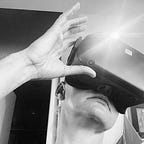Augmented reality — the next wave of reporting
The following is based on a workshop I did at the Associated Press a few weeks ago, and comments from a Matter.vc panel I spoke on last month.
While a number of media outlets have experimented with virtual reality and 360 video, far fewer have used augmented reality as a storytelling device. The New York Times has launched a few features, including a piece on Olympic athletes and another on David Bowie; the BBC launched a companion app for Civilizations; and USA Today built an AR experience around a rocket launch. But more news outlets should start playing in the space, as AR is far more readily accessible to the average consumer and can used to illustrate stories in a way that helps visual learners see data and helps further the understanding of complex topics.
Take a health related news piece, for instance a feature about heart disease. Although it is a topic that touches almost every family, too few people are educated enough to understand how the heart really works and how disease manifests, and words on a page and flat illustrations can only go so far. Now imagine that an image of the heart can be placed in a space, blown up, explored, and pulled apart and then put back together, with detailed descriptions of exactly how everything works. Especially for younger readers, who have grown up on far more visual content than printed matter, this can help tell the story in a new way.
A more data driven story can also find a new audience with AR features. Charts and pie graphs can make even the most compelling information seem deathly dull, and augmented reality allows readers to interact with the data and visualize it in new ways, especially if it can be presented as a layer on top of the physical world for context. Site-specific local reporting could be fascinating and have a long shelf life, and keep new people returning to a location and extend the reach of an article.
For many people, reporting on environmental issues feels far removed from their daily reality — we all complain about the wonky weather, but almost no one has been able to explore melting polar ice caps, for example. Allowing readers to put them in an intimate space and pull them apart to explore makes something that was once theoretical feel more tangible and real, and can spur action or more learning.
While the upfront costs of creating AR assets is an expense, many of them will wind up being reusable with minor tweaking — the equivalent of a great stock photo that gets used over and over. For now, these assets have to live in an app; given that many news sites already have a designated app where users consume content, this isn’t a major hurdle. In a few months, augmented reality will be able to be viewed via a web browser, and then anyone with a link and smartphone can partake in the content.
Augmented reality will fundamentally transform journalism as we know it, and we’ve barely started to scratch the surface. If you’re interested in learning more, reach out via the Friends With Holograms site.
